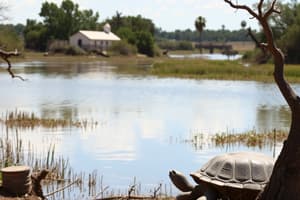Podcast
Questions and Answers
What are the two parts of a turtle's shell?
What are the two parts of a turtle's shell?
- Dorsal and ventral
- Scutes and vertebrae
- Carapace and plastron (correct)
- Ribs and sternum
What is unique about a turtle's skeletal system?
What is unique about a turtle's skeletal system?
- Their ribs are longer than their vertebrae
- They have no cartilage
- Their vertebrae are fused to their shell (correct)
- They have extra limbs
What type of metabolism do turtles have?
What type of metabolism do turtles have?
- Fast metabolism
- Variable metabolism
- Constant metabolism
- Slow metabolism (correct)
What is unique about a turtle's digestive system?
What is unique about a turtle's digestive system?
Where can turtles be found?
Where can turtles be found?
What is true about turtles' body temperature regulation?
What is true about turtles' body temperature regulation?
Why are many turtle species threatened or endangered?
Why are many turtle species threatened or endangered?
What is a crucial role of turtles in their ecosystems?
What is a crucial role of turtles in their ecosystems?
Flashcards are hidden until you start studying
Study Notes
Physical Characteristics
- Turtles have a shell that is made up of two parts: the carapace (dorsal) and the plastron (ventral)
- The shell is made of bony plates called scutes, which are derived from modified ribs and vertebrae
- Turtles have a unique skeletal system, with their ribs and vertebrae fused to the shell
- They have a slow metabolism, which allows them to survive on limited food resources
- Turtles have webbed feet or flipper-like limbs, adapted for swimming and walking
Diet and Nutrition
- Turtles are omnivores, feeding on aquatic plants, algae, insects, and small animals
- Some species are specialized to feed on specific food sources, such as jellyfish or seaweed
- Turtles have a unique digestive system, with a large cecum that houses a diverse community of microbes to aid in cellulose digestion
Habitat and Distribution
- Turtles are found in oceans, rivers, lakes, and wetlands around the world, from tropical to temperate regions
- They inhabit a wide range of aquatic environments, from coral reefs to freshwater swamps
- Some species are adapted to terrestrial environments, such as the tortoises
Behavior and Migration
- Turtles are ectothermic, relying on external sources of heat to regulate their body temperature
- They have a strong homing instinct, often migrating long distances to reach their breeding or nesting grounds
- Turtles exhibit unique mating behaviors, such as the complex courtship displays of some species
Conservation Status
- Many turtle species are threatened or endangered due to habitat destruction, hunting, and the pet trade
- Conservation efforts focus on habitat preservation, species reintroduction, and regulation of the pet trade
- Turtles play a crucial role in maintaining ecosystem balance, serving as both predators and prey in their ecosystems
Physical Characteristics
- Turtles have a dual shell comprising the carapace (dorsal) and plastron (ventral), made up of bony plates called scutes.
- Scutes are derived from modified ribs and vertebrae, which are fused to form the shell.
- Turtles have webbed feet or flipper-like limbs, adapted for swimming and walking, indicating their aquatic and terrestrial capabilities.
Diet and Nutrition
- Turtles are omnivores, feeding on a diverse range of food sources, including aquatic plants, algae, insects, and small animals.
- Some species exhibit specialized feeding habits, such as jellyfish or seaweed consumption, showcasing their adaptability.
- The unique digestive system of turtles features a large cecum, which houses a diverse community of microbes to aid in cellulose digestion.
Habitat and Distribution
- Turtles inhabit a wide range of aquatic environments, including oceans, rivers, lakes, and wetlands, across tropical and temperate regions.
- Some species are adapted to terrestrial environments, such as tortoises, demonstrating their ability to thrive in different ecosystems.
Behavior and Migration
- Turtles are ectothermic, relying on external sources of heat to regulate their body temperature, making them dependent on their environment.
- They exhibit a strong homing instinct, often migrating long distances to reach their breeding or nesting grounds, highlighting their remarkable navigation abilities.
- Unique mating behaviors, such as complex courtship displays, are characteristic of some turtle species.
Conservation Status
- Habitat destruction, hunting, and the pet trade have contributed to the threatened or endangered status of many turtle species.
- Conservation efforts focus on habitat preservation, species reintroduction, and regulation of the pet trade to protect turtle populations.
- Turtles play a crucial role in maintaining ecosystem balance, serving as both predators and prey in their ecosystems, and their conservation is essential for environmental sustainability.
Studying That Suits You
Use AI to generate personalized quizzes and flashcards to suit your learning preferences.




